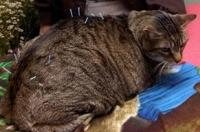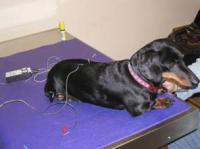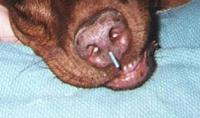Pet Acupuncture
Pet acupuncture is the placement of fine needles in certain parts of the body. It is used to improve health or treat disease. Acupuncture started over 2,000 years ago in China. It has been used in this country since the 70’s and can be a great option for alternative pet therapy in addition to, or instead of, conventional treatments.
The Chinese talk about Qi (chee), the body’s energy or life force. They believed that Qi moved through the body along specific pathways called meridians. Acupuncture points are places on the meridians where you can reach the Qi and have effects on the body. They produced charts showing where the meridians ran and where the points were located.
Alternative Medicine for Pets
Whether Qi actually exists doesn’t really matter. We know pet acupuncture works through the nervous system. Some points cause the release of hormones or chemicals within the body (such as endorphins). It helps the body to heal itself. Acupuncture controls pain and helps muscles relax. It also reduces inflammation and increases blood flow.
All of these effects help arthritis and other painful problems. It can also speed healing. This is especially helpful for paralyzed pets to help them walk again. Certain points have calming effects while others can help a pet whose heart has stopped. It can reduce congestion in the nose and open up the lungs. It can increase the appetite of pets that aren’t eating well, control nausea, vomiting, and diarrhea. Acupuncture can increase white blood cells and improve the immune system. It helps internal organs function better. This is how it helps kidney and liver diseases. Acupuncture can help with almost any health problem.
Methods
There are different ways to stimulate pet acupuncture points. The most common, and what everyone thinks of, is placing needles into the point. The needles are very fine and cause little discomfort.
Another alternative pet therapy method is to inject the point with a solution, often vitamin B12. The pressure from the fluid stimulates the point. Electricity can be applied to a set of points to produce a stronger effect. Some vets use this method for paralysis.
For some conditions, you can apply heat to the point. This is helpful for problems that are aggravated by cold and often helps geriatric pets.
Lasers or red light devices can also be used to stimulate the points. Both types have certain wavelengths of light that will go through the skin and affect the point.
Finally, you can stimulate the points by putting pressure on them with your finger. This method is called “Accupressure” and works well for pet parents to do at home. The method used depends on the problem and the pet. Often laser lights are used to treat points on paws that are more sensitive to needles.
What it Treats
Alternative medicine for pets like pet acupuncture is excellent for pain. It has been used to treat many patients with arthritis, hip dysplasia, and similar problems. The majority were able to move more easily and felt better. Many would become more playful.
Acupuncture can also be used for the treatment of neurological problems, such as paralysis, which are often caused by slipped disks in the spinal column. Successful pet acupuncture treatments have also been done on pets with skin problems and even urinary or kidney problems.
Acupuncture may also provide symptomatic relief and need to be used on a more regular basis, such as with chronic sinus problems or symptomatic problems associated with chronic conditions like megaesophagus or megacolon. Acupuncture can be used to treat pets that have stopped breathing or whose heart has stopped.
Pet acupuncture is widely accepted by medical professionals today and is quite safe when done by a trained veterinary acupuncturist. It can be used in combination with other types of alternative pet therapy and alternative medicine for pets. Check the International Veterinary Acupuncture Society to find a Certified Veterinary Acupuncturist.
Summary
How do they hold still and let you poke them with needles? Pets are great patients! The biggest problem is when a pet is nervous at the vet’s office. Then just move slowly, and they tend to learn it’s not hurting them and they actually felt better after. Plenty of treats help too.
All articles are reviewed and maintained by whiskerDocs team of veterinary experts.




